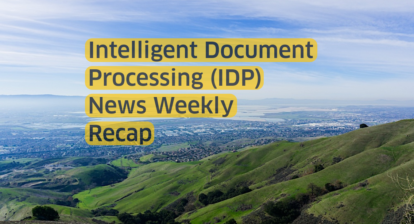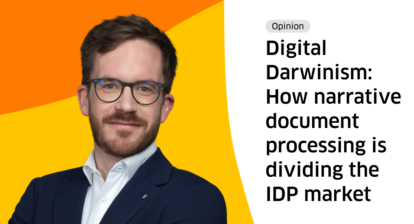Curious about what keeps experts, CEOs and other decision-makers in the Intelligent Document Processing (IDP) space on their toes? Get food for thought on IDP-related topics from the industry’s leading minds.
In this opinion piece, Brian DeWyer, CTO and Co-Founder of Reveille Software, a provider of management and monitoring solutions for Intelligent Process Automation-based applications, explains his five-step process to create an effective ECM strategy.
Information can be found in many locations and dispersed among numerous channels, such as SaaS tools, emails, cloud-hosted data, and mobile devices. Enterprise Content Management (ECM, aka Content Services) solutions help keep track, protect, and ensure access to vast information, no matter its location. Processes, tools, and policies for organizing, storing, managing, and accessing are indispensable aspects of an ECM strategy for document management. ECM is a component of Intelligent Process Automation-based applications. Intelligent Process Automation solutions typically include Intelligent Document Processing (IDP), Enterprise Content Management (ECM), and Robotic Process Automation (RPA) based components.
However, using multiple ECM solutions (often in large enterprises) could strain your teams and drain resources, siphoning talent away from other essential tasks. Establishing a thoughtful ECM strategy will help streamline content management and ensure the overall solution is providing benefits such as:
- Optimized Resource Allocation – Unifies content management processes, reducing manual effort and time spent searching for information. The efficiency gained also reduces wasted resources and maximizes productivity.
- Risk Mitigation – Outlines how data is accessed and handled, reducing security risks and thefts.
- Streamlined Business Processes – Integrates different tools to create seamless workflows and processes.
- Cost Reduction – Helps remove content inefficiencies, leading to significant cost savings and improved operational efficiency.
Creating an effective ECM strategy is not as daunting as it may seem; following this five-step process will guide you to success:
1. Assess and Define Objectives
The first step involves defining goals concerning:
- Content Access Efficiencies
- Hardcopy Paper Reduction
- Improved Records Management
- Creating Seamless Workflows
The best approach to organizing your ECM is to identify purposes and objectives, which will allow you to know your priorities. Step #1 helps focus on understanding the content needed, modifying support workflows, and decreasing support resolution time.
2. Perform a Content Audit
A comprehensive audit is needed to identify all types of content generated, utilized, and stored across the enterprise. The Step #2 audit needs to include:
- Standard Order of Process (SOP)
- Restricted, Confidential, Confidential Secret Documents – use your document classifications
- Emails
- Images and Video Files
- Other Multimedia Formats
The audit aims to provide a comprehensive understanding of all content categories and understand your ROT (redundant, trivial, or obsolete content). The significant concentration categories are relevance, sensitivity, workflows, and business value. Once the content is understood and the gaps identified, it’s time to get all stakeholders on board to gather their input.
3. Set Guidelines for Content Governance and Security
Due to the prevalence of hacks, most ECM systems have security features, but not all would be considered fail-safes. Governance policies and guidelines are added requirements to decrease attack surfaces. However, you won’t have to start from scratch when building with agentless ECM monitoring tools. Agentless tools enable you to observe multiple ECM systems faster, proactively identify access issues, detect and contain suspicious content access behavior, and initiate trouble tickets for quicker resolution.
4. Develop a Roadmap
The roadmap is the most crucial step before implementing an ECM strategy. It must be a detailed guide to deploying the strategy—whether a phased or comprehensive deployment. If the phased approach is adopted, it’s important to establish milestones. Many companies choose to first deploy ECM strategies for specific tech-savvy groups who can help work out the scalability bugs and streamline the rollout process for other non-technical teams.
5. Integrate Your Tools and Systems
The ECM system needs full integration with complementary systems and tools to assist with collaboration activities for optimal performance. For example, suppose a CRM tool is currently being used. In that case, it must incorporate the new ECM system to enable easy import and export of mailing lists, customer information, purchase history, previous customer support interactions, etc. This integration eliminates silo content problems, simplifying overall information access. It’s important to note that if multiple ECM tools are in use, you’ll need to strategize with IT teams to integrate them to improve overall content collaboration. The benefits of such integration include improved data accessibility, streamlined workflows, and enhanced collaboration, all of which contribute to a more efficient ECM strategy. Numerous low code options are now available to dramatically reduce the time and cost to integrate multiple applications (either SaaS or on-premises) with ECM.
Conclusion
ECM deployment must be well-thought-out for the desired outcome to be realized. In addition, ECM monitoring must be implemented to ensure easy access to essential documents for business processes and client services. A lack of ECM monitoring often results in lost information or difficult-to-access materials, stalling beneficial progress. In addition, IT security is paramount. Without adequate protection, chaos could ensue, trust eroded, and financial losses could mount as legal issues are contested. Emphasizing the importance of ECM monitoring should reassure you about the security of your documents.

About the Author
Brian DeWyer is CTO and Co-Founder of Reveille Software. With more than 25 years of experience in technology, Brian DeWyer provides product strategy and technical leadership in his role as Reveille CTO and board member. Brian leverages his extensive knowledge from his tenure as a senior IT leader at Wachovia and previous role as a process consulting practice leader for IBM Global Services delivering on-premises and cloud-based solution implementations for Fortune 1000 commercial and government clients. He has led process change efforts within large organizations, building on content-driven solutions for high-volume transaction processing applications. He is a past board member of the Association of Image and Information Management (AIIM) industry association. Brian graduated from Virginia Tech with a BSME and holds an MBA from Wake Forest University.
You may also like:

📨Get IDP industry news, distilled into 5 minutes or less, once a week. Delivered straight to your inbox ↓







